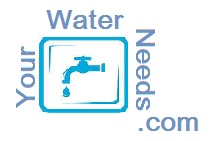|
| |
Chlorine Shocking Your Well
If your water test indicates the presence
of total coliform or E. coli bacteria and a sanitary survey does not
indicate any obvious source of contamination you should consider giving your
well a chlorine shock. This can clear up an accidental one time infection.
Equipment you will need includes:
- a clean water hose to reach from the
closest outside faucet to well
- a clean container (for storing the
sanitary well seal)
- standard household bleach (5.25% sodium
hypochlorite solution); use a bleach that is unscented
- a wrench to remove the well cap
Procedure:
- Bypass your water treatment equipment
(if present). Follow the manufacturer's recommendation for cleaning water
treatment equipment at this time.
- Determine the depth of water in the
well and use the table and formula below to determine the volume of bleach
needed to obtain a 50 ppm chlorine solution in the well water:
| Drilled Well
Diameter
| Multiplier
|
| Shallow Well
Diameter
| Multiplier
|
| 4 inches
| 0.084
|
| 2 feet
| 3.008
|
| 6 inches
| 0.188
|
| 3 feet
| 6.786
|
| 8 inches
| 0.334
|
| 4 feet
| 12.03
|
Dose (Volume of Bleach in Ounces) =
Depth of Water in Well (feet) x Multiplier
- Remove the sanitary well seal.
- Pour the correct chlorine dose into
the well.
- Attach a hose to an outside faucet
(must be located after the pressure tank).
- Circulate the water from the well
through the plumbing, hose, and back to the top of the well by opening the
faucet supplying the hose.
- After a strong chlorine smell is
detected in the water from the hose, slowly rotate the discharge end of the
hose around the inside of the well casing and down along the drop pipe to
the pump. (This allows the chlorine solution to wash down the interior
walls of the well casing, the exterior of the pump drop line, and the pump
wiring.)
- Continue this wash with the
chlorinated water for at least 15 minutes. Allow the hose to run
continuously into the well while you proceed to disinfect the plumbing
system.
- Open each faucet until a strong
chlorine smell is detected. Don't forget outside faucets, washing machines,
icemakers, etc.
- Shut off all taps and the re-circulation hose.
- Replace the sanitary well seal.
- Allow the chlorinated water to remain
in the system (refrain from water use) for at least 8 hours, and preferably
overnight.
- Connect the hose to an outside faucet
and flush the chlorinated water to an innocuous area (not into a septic
system). Flush until chlorine can no longer be smelled.
- Repeat flushing at each faucet in the
system.
- Place water treatment equipment back
into service.
- A bacteriological analysis can be
performed when chlorine is no longer present.
- Please remember that any new works
(repairs or improvements) must be properly disinfected.
|

